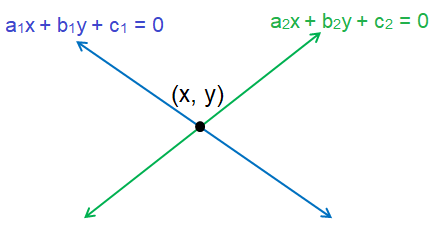FIND THE POINT OF INTERSECTION OF THE LINES
Subscribe to our ▶️ YouTube channel 🔴 for the latest videos, updates, and tips.
Point of Intersection :
Point of intersection means the point at which two lines intersect.
These two lines are represented by the equation
a1x + b1y + c1 = 0
a2x + b2y + c2 = 0

(x, y) is the point of intersection of the lines.
Problem 1 :
y = x + 4
5x – 3y = 0
Solution :
Given lines,
y - x = 4 -----(1)
5x – 3y = 0 -----(2)
(1) × (-3) ==> 3x - 3y = -12 ----(3)
Using Elimination Method :
Subtract (3) - (2), we get
3x - 3y - 5x + 3y = -12 - 0
-2x = -12
x = 6
By substituting x = 6 in (1), we get
y – 6 = 4
y = 4 + 6
y = 10
So, the point of intersection of the lines is (6, 10).
Problem 2 :
x + 2y = 8
y = 7 – 2x
Solution :
Given,
x + 2y = 8 -----(1)
2x + y = 7 -----(2)
(1) × 2 ==> 2x + 4y = 16 ----- (3)
Subtract (3) - (2), we get
2x + 4y - 2x - y = 16 - 7
3y = 9
y = 3
By substituting y = 3 in (1), we get
x + 2(3) = 8
x + 6 = 8
x = 8 – 6
x = 2
So, the point of intersection of the lines is (2, 3).
Problem 3 :
x – y = 5
2x + 3y = 4
Solution :
x – y = 5 ----- (1)
2x + 3y = 4 ----- (2)
(1) × 3 ==> 3x – 3y = 15 ----- (3)
Add (3) + (2), we get
3x - 3y + 2x + 3y = 15 + 4
5x = 19
x = 19/5
x = 3.8
By substituting x = 19/5 in (1), we get
19/5 – y = 5
- y = 5 – 19/5
- y = (25 – 19) / 5
- y = 6/5
y = -6/5
y = -1.2
So, the point of intersection of the lines is (3.8, -1.2).
Problem 4 :
2x + y = 7
3x – 2y = 1
Solution :
2x + y = 7 ----- (1)
3x – 2y = 1----- (2)
(1) ∙ 2 ==> 4x + 2y = 14 ----- (3)
Add (3) + (2), we get
4x + 2y + 3x - 2y = 14 + 1
7x = 15
x = 15/7
x = 2.14
By substituting x = 15/7 in (1), we get
2(15/7) + y = 7
30/7 + y = 7
y = 7 – 30/7
y = (49 – 30) / 7
y = 19/7
y = 2.71
So, the point of intersection of the lines is (2.14, 2.71).
Problem 5 :
y = 3x – 1
x – y = 6
Solution :
-3x + y = -1 -----(1)
x – y = 6 -----(2)
Add (1) + (2), we get
-3x + y + x - y = -1 + 6
-2x = 5
x = -5/2
x = -2.5
By substituting x = -5/2 in (1), we get
-3(-5/2) + y = -1
15/2 + y = -1
y = -1 – 15/2
y = (-2-15) / 2
y = -17/2
y = -8.5
So, the point of intersection of the lines is (-2.5, -8.5).
Problem 6 :
y = -2x/3 + 2
2x + y = 6
Solution :
2x/3 + y = 2 ----- (1)
2x + y = 6 ----- (2)
Subtract (1) - (2), we get
2x/3 + y - 2x - y = 2 - 6
- 4x/3 = - 4
-4x = -12
x = 3
By substituting x = 3 in (1), we get
2(3/3) + y = 2
2 + y = 2
y = 2 – 2
y = 0
So, the point of intersection of the lines is (3, 0).
Problem 7 :
If 5x + 3y = 12 and 4x - 5y = 17, what is the value of y ?
a) -1 b) 3 c) (-1, 3) d) (3, -1)
Solution :
The given equations are
5x + 3y = 12 -------(1)
4x - 5y = 17 -----(2)
(1) ⋅ 5 + (2) ⋅ 3
25x + 15y + 12x - 15y = 60 + 51
37x = 111
x = 111/37
x = 3
Applying x = 3 in (1), we get
5(3) + 3y = 12
15 + 3y = 12
3y = 12 - 15
3y = -3
y = -3/3
y = -1
So, option a is correct.
Problem 8 :
Determine the number of solutions of the system x + 2y = -1 and 2x + 4y = -2
a) 0 b) 1 c) 2 d) Infinitely many
Solution :
x + 2y = -1 ------(1)
2x + 4y = -2 -------(2)
Dividing (2) by 2, we get
x + 2y = -1
Since both equations are the same, they must be coincide and it may have infinitely many solutions.
Subscribe to our ▶️ YouTube channel 🔴 for the latest videos, updates, and tips.
Recent Articles
-
Finding Range of Values Inequality Problems
May 21, 24 08:51 PM
Finding Range of Values Inequality Problems -
Solving Two Step Inequality Word Problems
May 21, 24 08:51 AM
Solving Two Step Inequality Word Problems -
Exponential Function Context and Data Modeling
May 20, 24 10:45 PM
Exponential Function Context and Data Modeling